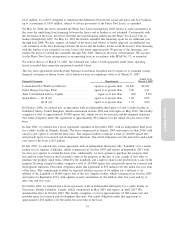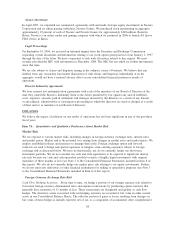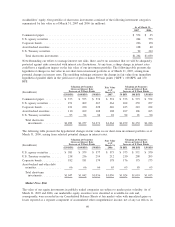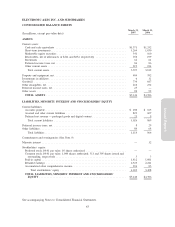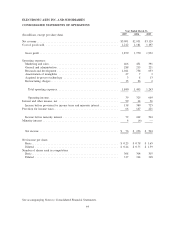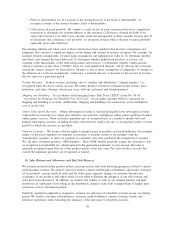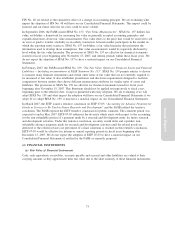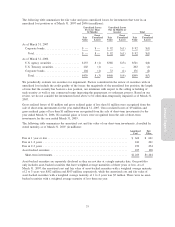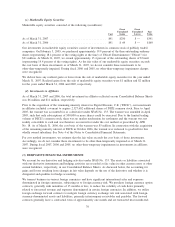Electronic Arts 2007 Annual Report Download - page 141
Download and view the complete annual report
Please find page 141 of the 2007 Electronic Arts annual report below. You can navigate through the pages in the report by either clicking on the pages listed below, or by using the keyword search tool below to find specific information within the annual report.
ELECTRONIC ARTS INC. AND SUBSIDIARIES
NOTES TO CONSOLIDATED FINANCIAL STATEMENTS
(1) DESCRIPTION OF BUSINESS AND SUMMARY OF SIGNIFICANT ACCOUNTING POLICIES
We develop, market, publish and distribute interactive software games that are playable by consumers on video
game consoles (such as the Sony PlayStation»2 and PLAYSTATION»3, Microsoft Xbox 360
TM
and Nintendo
Wii
TM
), personal computers, mobile platforms (including cellular handsets and handheld game players such as
the PlayStation»Portable (“PSP
TM
”) and the Nintendo DS
TM
) and online (over the Internet and other proprietary
online networks). Some of our games are based on content that we license from others (e.g., Madden NFL
Football, The Godfather and FIFA Soccer), and some of our games are based on our own wholly-owned
intellectual property (e.g., The Sims
TM
and Need for Speed
TM
). Our goal is to publish titles with mass-market
appeal, which often means translating and localizing them for sale in non-English speaking countries. In
addition, we also attempt to create software game “franchises” that allow us to publish new titles on a
recurring basis that are based on the same property. Examples of this franchise approach are the annual
iterations of our sports-based products (e.g., Madden NFL Football, NCAA»Football and FIFA Soccer),
wholly-owned properties that can be successfully sequeled (e.g., The Sims, Need for Speed and Battlefield)
and titles based on long-lived literary and/or movie properties (e.g., Lord of the Rings and Harry Potter).
A summary of our significant accounting policies applied in the preparation of our Consolidated Financial
Statements follows:
(a) Consolidation
The accompanying Consolidated Financial Statements include the accounts of Electronic Arts Inc. and its
wholly- and majority-owned subsidiaries. All significant intercompany balances and transactions have been
eliminated in consolidation.
(b) Fiscal Year
Our fiscal year is reported on a 52 or 53-week period that, historically, ended on the final Saturday of March
in each year. Beginning with the fiscal year ended March 31, 2006, our fiscal year ends on the Saturday
nearest March 31. As a result, fiscal 2006 contained 53 weeks with the first quarter containing 14 weeks. Our
results of operations for the fiscal years ended March 31, 2007, 2006 and 2005 contain the following number
of weeks:
Fiscal Year Ended Number of Weeks Fiscal Period End Date
March 31, 2007......................................... 52weeks March 31, 2007
March 31, 2006......................................... 53weeks April 1, 2006
March 31, 2005......................................... 52weeks March 26, 2005
For simplicity of disclosure, all fiscal periods are referred to as ending on a calendar month end.
(c) Reclassifications
Certain prior-year amounts have been reclassified to conform to the fiscal 2007 presentation.
(d) Use of Estimates
The preparation of financial statements in conformity with accounting principles generally accepted in the
United States requires us to make estimates and assumptions that affect the reported amounts of assets and
liabilities, contingent assets and liabilities, and revenue and expenses during the reporting period. Such
estimates include sales returns and allowances, provisions for doubtful accounts, accrued liabilities, income
taxes, estimates regarding the recoverability of prepaid royalties and royalty commitments, inventories, long-
lived assets, certain estimates related to the measurement and recognition of costs resulting from our share-
based payment transactions, deferred income tax assets as well as estimates used in our goodwill impairment
Annual Report
67


